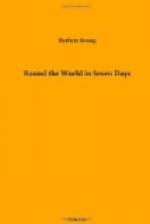His concern now was to pick up the light which, according to the Admiralty’s sailing directions, shone from an iron structure a hundred and twenty feet high, about a mile south of Point Charles, the western extremity of Port Darwin. Approaching the port from the west, as he was, he should have no difficulty in seeing the light at a distance of eighteen or twenty miles, the sky being clear. But as time went on neither he nor Rodier caught sight of the red speck for which they were looking. Half-past eight came, local time, as nearly as Smith could calculate it by his watch, which still registered London time; and even allowing for the hours lost he should by now have touched land. He was beginning to feel anxious when he suddenly found land below him—a land of dense forests, apparently low and flat. The question was, whether this was the mainland of Australia or an island, possibly Bathurst Island, north of Port Darwin. It was impossible to tell. There was no time to ponder or weigh possibilities; yet if he took the wrong course he might be hours in discovering his mistake, and this part of Australia being almost wholly uninhabited he might fail to find any guidance even if he descended. By a rapid guess—it could not be called reasoning—he concluded that he had probably steered a too southerly course, and that he would do right if he now steered to the north-east. His indecision had lasted only a few seconds; he brought the aeroplane round until she flew over the line of breakers washing the shore, and followed the coast at full speed.
Within a quarter of an hour both the men caught sight at the same moment of the red glow of the light, which grew in brilliance as they approached it, and then diminished as the lamp revolved. Steering now to the east, in ten minutes they were sailing over the town of Palmerston, the capital of the Northern Territory. The lighted streets, crossing at right angles, formed a pattern below them like the diagram for the game of noughts and crosses. They found a landing place a little to the north-east of the town, beyond the railway, and having safely come to earth, Smith left Rodier to attend to the engine and hastened towards the nearest house, a sort of bungalow of wood and iron. Sounds of singing came from within.




